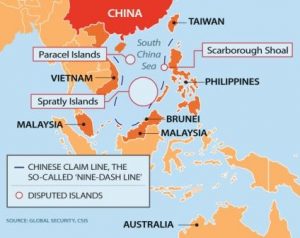By Suresh Somu

Jakarta . 01 August 2020. All is not calm in the waters of South China Sea. Geopolitical times have been tense in recent months as China has been flexing its muscles to trumpet its territorial maritime dominance. Initially, Indonesia and China crossed watery-swords arising from the tensions in Natuna Island. Another standoff flared up with Vietnamese vessels with the Chinese government survey ship, near Malaysia.
Uneasy times continued with the Haiyang Dizhi 8 surveying in resource-rich waters 352 km off the coast of Brunei and Malaysia; a global flashpoint as the United States challenges China’s sweeping maritime claims. Last year, China Chinese Coast Guard vessel spent weeks in waters close to oil rig in a Vietnamese oil block while the Haiyang Dizhi 8 conducted suspected oil exploration surveys in Vietnam’s EEZ. Early January, Chinese encroachment in waters near Natuna Islands, prompted Indonesia to send warships and fighter jets forcing the boats to retreat.
US Pacific Fleet commander Admiral John Aquilino drew the tough lines when he said: “We are committed to a rules-based order in the South China Sea, and we will continue to champion freedom of the seas and the rule of law. The Chinese Communist Party must end its pattern of bullying South-east Asians out of offshore oil, gas and fisheries.”
Well clearly, might does not make it right, does it? The US State Department continues to urge Beijing to focus on combating the pandemic and “stop exploiting the distraction or vulnerability of other states to expand its unlawful claims in the South China Sea”. It has also responded to Beijing’s recent moves by increasing its patrols and naval exercises in the region with Australia joining in.
TERRITORIAL AMBITIONS
Secretary of State Mike Pompeo warned Asean foreign ministers that China has moved to “take advantage of” the distraction of the pandemic to push its territorial ambitions in the South China Sea. And the United States wants Asean to stand up to what it calls “outside coercion” in the regional bloc’s own backyard. So, notwithstanding the relations between US and China has reached a low point, it clearly depicts the global powers are at loggerheads, which makes the overall situation nervy for the region.
For the record, the South China Sea is a major international seaway linking the Pacific and Indian oceans. It entails the second-busiest sea route in the world, through which more than half of the world’s large cargo vessels travel, and the region is rich in natural resources, which is why many countries are vying for control of it.
The US and China have said that sovereign claims to the sea should be resolved peacefully through talks, although given the complexity of the national territorial claims and huge economic interests in the control over the area, talk of seeking peaceful resolution is little more than artifice. The two great powers are mostly locking horns in multilateral or bilateral diplomatic strategic confrontations.
The US, since the 1995 Mischief Reef Incident, has declared its stance on four mayor issues concerning the region’s complex web of sovereignty claims. These are: the importance of maintaining regional peace and stability; preserving freedom of passage in the area; neutrality on the various sovereignty claims; and the desirability of ensuring solutions conforming to the Law of the Sea.
No doubts about it. The US is well aware that China is the cause of the instability in the South China Sea, and to guard against the continued expansion of the Chinese military, the US has not only reiterated its opposition to any military activity or intimidation that could affect economic activity in the region, it has also in the past few years consistently called for disputes to be resolved through multilateral talks. It is clearly a matter of concern for the US.
BILATERAL TALKS

China’s strategy has been to prevent the South China Sea disagreements from becoming multilateral in nature, and to push for the tensions to be resolved via bilateral talks. The intention is to deny third-party countries with influence in the region, such as the US, Japan or Australia, the opportunity to intervene.
It appears that the 10-nation bloc is struggling to reach consensus on issues related to China. Despite engaging China in various issues, from numerous frameworks to consultative meetings, ASEAN state members are yet to see the light at the end of the tunnel when it comes to territorial claims.
Let’s not forget that China is among ASEAN countries’ top trading partners too. And the region needs both, the US and China, without being wrestled to take sides. But the question begets: Does US want South-east Asia and ASEAN to ring-fence China?
According to Dr Ian Bremmer, chief executive of the Eurasia Group, a political risk consultancy: “US retrenchment from alliances and trade disintegration benefit China by preventing an united front and introducing uncertainty about which power smaller countries can rely on.”
And the fact that China’s recent actions continues to solidify of being untrustworthy and unveiling the scope of its geo-strategic ambition. While others argued that the actions in the disputed waters follow its long-term strategy and may even have been planned before the outbreak.
Analysts and observers opined ASEAN has to up its game; stand up to China moves, unified. The region should prevent China from making strategic gains and devote more resources to building capacity to defend the maritime spaces. But is it possible?
Well the honest truth, not when ASEAN is far from monolithic and countries has different stances and levels of integration with China makes the path challenging. It is complicated, South-east Asian countries face a conundrum in their complex relationship with their sizeable neighbour. And Beijing has been using economic benefits to win over some countries in South-east Asia too.
Associate Professor, Suseela Devi Chandran, University Teknologi MARA (UiTM) said, “While it is widely acknowledged ASEAN-China partnership has spurred regional economic growth, it is not the same when it comes to territorial claims. Despite several agreements, China would not give up their claimants as it wants to return to its’ Middle Kingdom era.”
“ASEAN and China has maintained good communication and collaboration within cooperation mechanics such as ASEAN Plus Three, ASEAN Regional Forum and East Asia Summit. But does that mean ASEAN has the confidence of China’s benign action on South China Sea matters? To me, it is still an unbalanced relationship aligned more to China than ASEAN” she remarked.
CHINA INTIMIDATION?
But when it comes to protecting sovereignty, there is no question about it. More so, countries that are claimants in the South China Sea should push back against Chinese intimidation where possible.
So kudos to Philippines who was pro-China in early stages and Vietnam to speak for itself. Referring to the Vietnamese boat ramming or being rammed incident, Vietnam foreign ministry in a statement said: “The Chinese vessel committed an act that violated Vietnam’s sovereignty over the Hoang Sa archipelago, threatened the lives and damaged the property and legitimate interests of Vietnamese fishermen.”
China could say what it wants, that the situation is being stable. But it is far from truth given the spate of events; its actions has triggered clear unease across the region.
In the contested waters, it has now established two administrative districts on the Parcel and Spratly archipelagos and naming 80 islands, reefs, shoals and ridges, of which 55 are under water. So pray tell me: Is this is China’s version of being stable?

























































































































